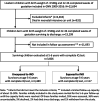Treatment With Inhaled Nitric Oxide and General Intelligence in Preterm Children in Two European Cohorts
- PMID: 40326486
- PMCID: PMC12336939
- DOI: 10.1111/apa.70118
Treatment With Inhaled Nitric Oxide and General Intelligence in Preterm Children in Two European Cohorts
Abstract
Aim: To investigate whether treatment with inhaled nitric oxide is associated with cognitive performance at age 5-6 years in preterm-born children.
Methods: We analysed preterm children from two large European cohort studies, the German Neonatal Network (GNN) (N = 3606) and the French EPIPAGE-2 cohort (N = 2579) admitted to neonatal care and followed up at age 5-6 years. Both cohorts had recorded data on iNO treatment. General cognitive ability was tested with IQ tests. Classification and Regression trees analysis was used to identify prenatal, perinatal and neonatal, clinical and social-environmental predictors of IQ.
Results: In both cohorts, treatment with inhaled nitric oxide was not associated with IQ at age 5-6 years. Analysis identified maternal educational level, gestational age at discharge from hospital, intraventricular haemorrhage and maternal country of birth as important factors associated with IQ scores.
Conclusion: Treatment with inhaled nitric oxide was neither negatively nor positively associated with IQ at age 5-6 years. Neonatal and brain health, as well as socioeconomic factors are important for cognitive performance in early childhood.
Keywords: IQ; cognitive function; inhaled nitric oxide; minipuberty; preterm birth.
© 2025 The Author(s). Acta Paediatrica published by John Wiley & Sons Ltd on behalf of Foundation Acta Paediatrica.
Conflict of interest statement
The authors declare no conflicts of interest.
Figures




References
Publication types
MeSH terms
Substances
Grants and funding
- 847941/European Commission
- 01ER0805/Bundesministerium für Bildung und Forschung
- 01ER1501/Bundesministerium für Bildung und Forschung
- French Institute of Public Health Research/Institute of Public Health and its partners: the French Health Ministry, the National Institutes of Health and Medical Research (INSERM), the National Institute of Cancer, and the National Solidarity Fund for Autonomy (CNSA)
- ANR-11-EQPX-0038/National Research Agency through the French EQUIPEX program of investments in the future
- ANR-19-COHO001/National Research Agency through the French EQUIPEX program of investments in the future
- PREMUP Foundation
- 11779/Fondation de France
- SPF20160936356/Fondation pour la Recherche Médicale
- DGOS13-040/Program Hospitalier de Recherche Clinique Epinutri
- G13129KK/Ministére de l'Enseignement Supérieur, De La Recherche et de L'Innovation
- R20065KK/Apicil Foundation
LinkOut - more resources
Full Text Sources

